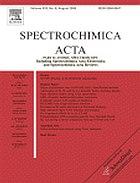|
Literature / Source Database:
Spectrochimica Acta, Part B: Atomic Spectroscopy
| Title (short) |
Spectrochim. Acta, Part B |
| Title (abbrev) |
SAB |
| CODEN |
SAASBH |
| Languages |
English, French, German |
| First year |
1967 |
| Impact factor |
3.101 |
| Editor |
M. de Loos-Vollebregt, N. Omenetto |
|
|

|
Status
active
Indexing
Analytical Abstracts, Aqualine Abstracts, BIOSIS, Cambridge Scientific Abstracts, Chemical Abstracts, Current Contents/Physics, Chemical, & Earth Sciences, Current Contents/SciSearch Database, Current Contents/Science Citation Index,
INSPEC, PASCAL
Predecessor
Subject

Source type
Journal
Publisher
ISBN ISSN
0584-8547
First volume
23
Last volume
167+
Publish city
Oxford, New York
Homepage
| Resources |
|
Availability |
|
|
|
|
|
| Text PDF |
 |
free access |
 |
| Text Html |
 |
for subscriber |
 |
| References |
 |
not available |
 |
| Abstracts |
 |
|
|
| TOC |
 |
|
|
|
|
|
|

Description
Spectrochimica Acta Part B: Atomic Spectroscopy, is intended for the rapid publication of both original work and reviews in the following fields:
- Atomic Emission (AES), Atomic Absorption (AAS) and Atomic Fluorescence (AFS) spectroscopy;
- Mass Spectrometry (MS) for inorganic analysis covering Spark Source (SS-MS), Inductively Coupled Plasma (ICP-MS), Glow Discharge (GD-MS), and Secondary Ion Mass Spectrometry (SIMS).
- Laser induced atomic spectroscopy for inorganic analysis, including non-linear optical laser spectroscopy, covering Laser Enhanced Ionization (LEI), Laser Induced Fluorescence (LIF), Resonance Ionization Spectroscopy (RIS) and Resonance Ionization Mass Spectrometry (RIMS); Laser Induced Breakdown Spectroscopy (LIBS); Cavity Ringdown Spectroscopy (CRDS), Laser Ablation Inductively Coupled Plasma Atomic Emission Spectroscopy (LA-ICP-AES) and Laser Ablation Inductively Coupled Plasma Mass Spectrometry (LA-ICP-MS).
- X-ray spectrometry, X-ray Optics and Microanalysis, including X-ray fluorescence spectrometry (XRF) and related techniques, in particular Total-reflection X-ray Fluorescence Spectrometry (TXRF), and Synchrotron Radiation-excited Total reflection XRF (SR-TXRF).
Manuscripts dealing with (i) fundamentals, (ii) methodology development, (iii)instrumentation, and (iv) applications, can be submitted for publication.
The emphasis is on papers having a relationship with "spectrochemical analysis". The main subjects will include theoretical or experimental studies of the physical and chemical processes connected with the generation of atomic or mass spectra; the determination of atomic data; diagnostics for spectrochemical sources; the fundamentals, design or performance of complete instrumental systems, components of instruments, or devices used in any of the above stated fields of spectrometry; qualitative and quantitative analysis in the sense of complete analytical procedures using a single method or a combination of methods, or parts of complete procedures: sampling, sample preparation, sample introduction, detection, data acquisition and handling (including calibration and statistical evaluation); analytical performance and analytical figures of merit: limits of detection and limits of determination, selectivity, precision, accuracy, interferences. Authoritative and comprehensive review articles, dedicated to a particularly important topic or field of analysis, are published regularly. In addition, shorter, concise reviews or viewpoints focusing on the current status and future prospects of a field or topic particularly relevant to the development of a new analytical methodology or to a better understanding of its fundamental underlying principles are welcome. Tutorial reviews, illustrating in depth fundamental concepts in atomic spectroscopy and analytical atomic spectroscopy, are also published.
Articles describing an application of a spectroscopic technique to analysis will also be considered. In this case, however, the spectroscopic flavor of the manuscript should be substantial: mere analytical recipes or papers emphasizing separation and pre-concentration techniques should not be submitted. Finally, to the editors' discretion, accelerated publication of short papers dealing with new important concepts, instrumental developments or applications will be considered.
Related links:
|